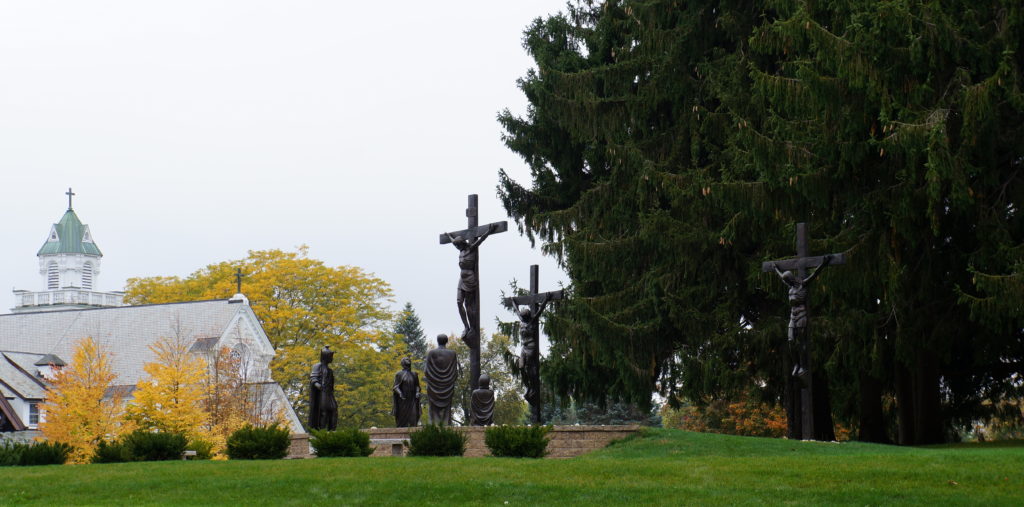the Beatitudes
Nerds that we are, whenever my husband or I are reading a good book, we will excitedly punch the other one in the shoulder and say, “Listen to this!” or “Can I read you something?” Several months ago, my husband was reading Life of Christ by Ven. Fulton Sheen and, with tears in his eyes, read out loud a passage from the chapter on the Beatitudes:
But let any man put these Beatitudes into practice in his own life, and he too will draw down upon himself the wrath of the world. The Sermon on the Mount cannot be separated from His Crucifixion, any more than day can be separated from night. The day our Lord taught the Beatitudes, He signed His own death warrant.
My husband was so visibly moved by the passage, I didn’t want to betray my confusion. How could that be so? I thought. The Beatitudes are so beautiful. In my head I imagined a hippie-like Christ sitting on a hill talking about blessed this and blessed that— idyllic, and nothing like the crucifixion. I knew I was missing something, but after a “hmmm” and a nod, I went back to reading my own book.
Fast-forward to now, Day 6 of the Consecration to Jesus through Mary, a day to ponder the Beatitudes. I read the familiar Scripture passage from Matthew 5, Blessed are the poor in spirit, for theirs is the kingdom of heaven, and so on. Yes, lovely; sure, powerful. But the next piece for reflection was from St. John Paul II’s homily from the Mount of Beatitudes in Israel in 2000. He said, “Jesus did not merely speak the beatitudes. He lives the Beatitudes. He is the Beatitudes.” I went back to the Scripture passage and began to read it differently: Jesus is poor in spirit… Jesus mourns… Jesus is meek… Jesus hungers and thirsts for righteousness… Jesus is merciful… Jesus is pure of heart… Jesus is a peacemaker… Jesus is persecuted…
The passage suddenly turned into an arrow that pierced my heart and I had to ask myself: Am I poor in spirit? Am I willing to mourn? Am I meek? Do I hunger and thirst for righteousness? Am I merciful? Am I pure of heart? Am I a peacemaker? How do I react to persecution?
I realized I had grazed over the Beatitudes most of my Christian life like the eunuch who meets Philip and says, “How can I read with no one to teach me?” I remembered Fulton Sheen’s words about the Beatitudes and immediately went looking on the bookshelf for Life of Christ. In just ten pages, he illuminates those twelve verses with piercing clarity: “Our divine Lord takes those eight flimsy catch-words of the world- ‘Security’, ‘Revenge’, ‘Laughter’, ‘Popularity’, ‘Getting Even’, ‘Sex’, ‘Armed Might’, and ‘Comfort’- and turns them upside down.” Sheen goes through each, discussing the opposition to each Beatitude. He finishes how he began:
Crucifixion cannot be far away when a Teacher says ‘woe’ to the rich, the satiated… the popular. Truth is not the Sermon on the Mount alone; it is in the One Who lived out the Sermon on the Mount on Golgotha… On the Mount of the Beatitudes, He bade men hurl themselves on the cross of self-denial; on the Mount of Calvary, He embraced that very cross.
John Paul II, at the close of his Beatitude homily, says, “[Christ] does not simply say, ‘Do as I say.’ He says, ‘Come follow me’.” When I read the Beatitudes as traits of Christ, I can see how saints like Mother Theresa or Damien of Molokai were willing to answer God’s call to serve the poorest of the poor, for in them they saw the face of their beloved Savior. Or in a more ordinary sort of way, Thérèse of Liseiux could react with charity to hurtful sisters and Chiara Badano could accept suffering and death at the hand of cancer because they followed Christ in the Beatitudes—knowing they were blessed in mourning, in persecution, in their meekness— not because they relished suffering, but because they loved Jesus and followed him to the mount.



